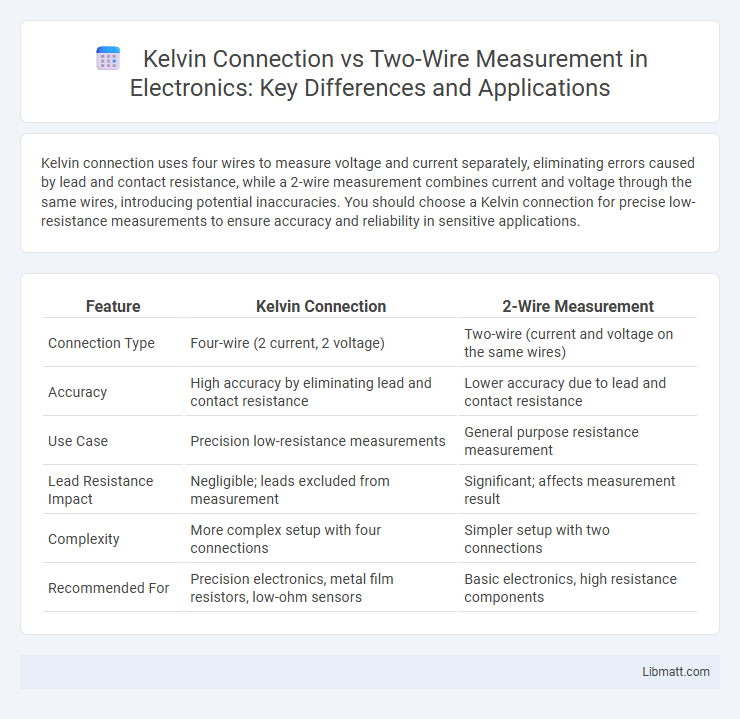Kelvin connection uses four wires to measure voltage and current separately, eliminating errors caused by lead and contact resistance, while a 2-wire measurement combines current and voltage through the same wires, introducing potential inaccuracies. You should choose a Kelvin connection for precise low-resistance measurements to ensure accuracy and reliability in sensitive applications.
Table of Comparison
| Feature | Kelvin Connection | 2-Wire Measurement |
|---|---|---|
| Connection Type | Four-wire (2 current, 2 voltage) | Two-wire (current and voltage on the same wires) |
| Accuracy | High accuracy by eliminating lead and contact resistance | Lower accuracy due to lead and contact resistance |
| Use Case | Precision low-resistance measurements | General purpose resistance measurement |
| Lead Resistance Impact | Negligible; leads excluded from measurement | Significant; affects measurement result |
| Complexity | More complex setup with four connections | Simpler setup with two connections |
| Recommended For | Precision electronics, metal film resistors, low-ohm sensors | Basic electronics, high resistance components |
Introduction to Electrical Measurements
Kelvin Connection, also known as four-wire measurement, significantly improves accuracy in electrical measurements by eliminating the effects of lead and contact resistance, which commonly affect two-wire measurements. In a two-wire setup, the same pair of leads carries current and measures voltage, causing measurement errors due to the resistance of the leads themselves. Your precision in low-resistance measurements will greatly benefit from the Kelvin Connection method, especially in applications requiring high accuracy and minimal signal distortion.
Understanding 2-Wire Measurement Basics
2-wire measurement uses the same pair of wires to supply current and measure voltage, which can introduce errors due to lead resistance affecting accuracy, especially in low-resistance or precision applications. Kelvin connection, also known as 4-wire measurement, employs separate pairs of wires for current supply and voltage sensing, effectively eliminating lead resistance errors and ensuring highly accurate measurements. Understanding the limitations of 2-wire measurements is essential when precision is critical, as lead resistance and contact resistance can significantly distort results.
The Principle of Kelvin (4-Wire) Connection
Kelvin connection, also known as 4-wire measurement, eliminates the errors caused by lead and contact resistance by using separate pairs of wires for current supply and voltage sensing. This principle allows precise measurement of low resistances by ensuring that the voltage drop across the test specimen is sensed without including lead resistance. The result is highly accurate resistance readings, critical in applications such as precision shunt resistors and strain gauges.
Key Differences Between 2-Wire and 4-Wire Methods
2-wire measurement uses the same pair of wires for current supply and voltage sensing, often resulting in inaccurate readings due to lead resistance. Kelvin connection, also known as 4-wire measurement, employs separate pairs of wires for current and voltage, effectively eliminating the influence of lead resistance and ensuring precise voltage measurements. This key difference makes Kelvin connection ideal for low-resistance measurements in precision electrical testing applications.
Accuracy and Error Analysis
Kelvin connection significantly improves accuracy by eliminating lead and contact resistance from the measurement circuit, enabling precise low-resistance readings crucial in applications like shunt resistor calibration. In contrast, 2-wire measurement suffers from errors introduced by resistance in test leads and contact points, causing inflated resistance values and reduced reliability. Error analysis shows Kelvin connection can achieve milliohm-level precision, while 2-wire methods often exhibit significant deviations due to parasitic resistances, making Kelvin connection the preferred choice for high-accuracy resistance measurements.
Typical Applications for Each Method
Kelvin connection is typically used in precision low-resistance measurements, such as evaluating shunt resistors, battery internal resistance, and contact resistance in electrical components. Two-wire measurement is commonly applied in general resistance testing where high accuracy is not critical, including basic wiring checks and simple electronic component tests. The Kelvin method minimizes lead and contact resistance errors, making it ideal for high-accuracy industrial and laboratory applications.
Advantages of Kelvin Connection
Kelvin Connection measurements minimize lead and contact resistance errors by using separate pairs of wires for current supply and voltage sensing, ensuring highly accurate resistance readings even at low values. This technique significantly improves precision in applications such as low-resistance measurements in electronics, battery testing, and material characterization. The four-wire configuration effectively eliminates the impact of lead resistance and thermal EMF, which are common sources of error in traditional 2-wire measurements.
Limitations of 2-Wire Measurement
2-wire measurement is limited by the resistance of the test leads, which introduces significant error in low-resistance measurements and reduces overall accuracy. This method cannot compensate for lead resistance or contact resistance, making it unsuitable for precise current sensing or small voltage drop measurements. You should consider Kelvin connections for applications requiring high-precision resistance measurements as they eliminate lead resistance errors by using separate current and voltage paths.
How to Choose the Right Measurement Technique
Choosing the right measurement technique depends on the accuracy required and the resistance levels of your components. Kelvin connection, or 4-wire measurement, is ideal for low-resistance measurements by eliminating lead and contact resistance, ensuring precise results. For higher resistance values where lead resistance is negligible, a 2-wire measurement offers simplicity and faster setup without compromising significant accuracy.
Summary and Best Practices
Kelvin connection, also known as 4-wire measurement, enhances accuracy by using separate pairs of wires for current supply and voltage sensing, effectively eliminating lead and contact resistance errors common in 2-wire measurements. Best practices for Kelvin connections include ensuring proper four-terminal probe placement directly at the test sample and maintaining tight, low-resistance contacts to minimize measurement noise and parasitic resistances. For applications requiring high precision in resistance measurements below 1 ohm, Kelvin connections are preferred over 2-wire methods due to their superior accuracy and repeatability.
Kelvin Connection vs 2-wire Measurement Infographic

 libmatt.com
libmatt.com